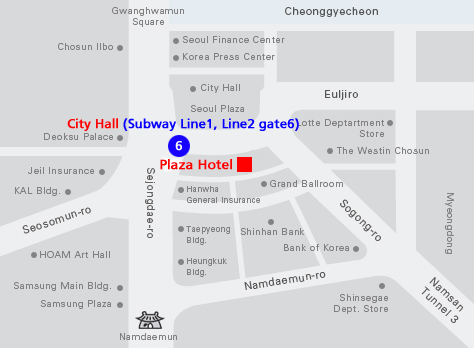Conference dinner
Conference dinner (Plaza Hotel)
The conference dinner will be on Thursday, 27th June, 2013 and will begin at 7:00 PM at the Grand Ballroom B2F in Plaza Hotel Seoul.
For each participant and accompanying person the amount of 80,000 Won has to be paid in advance. More details can be found in the online registration form, where you can also specify how many additional persons you wish to bring.
There will be a thirty-minute concert(Korean traditional music, Gukak) during the conference dinner.
Bus Service to Plaza Hotel : In front of J Hall 4th floor main gate (PM 6:00~6:30)
http://www.hoteltheplaza.com/eng/index.jsp
Location

ADDRESS : 119 SOGONG-RO, JUNG-GU, SEOUL, KOREA 100-864
PHONE : 82-2-771-2200
FAX : 82-2-755-8897
SUBWAY
Get off at City Hall Station (Line 1 or 2), take exit no. 6 and walk about 1~2 minutes.
Hotel Local Guide Information
: http://www.hoteltheplaza.com/eng/hotel/guide.jsp
Recommended Surrounding
Cheonggyechon Stream (청계천)
Cheonggyecheon Stream used to exist merely as an overpass neglected in 1970 until it was restored in 2005, becoming a haven of natural beauty amidst the bustle of city life.
Gwanghwamun (광화문)
Founded in 1395 by the first king of the Joseon Dynasty, Gwanghwamun is the main gate of Gyeongbukgung Palace. Literally translated, its name means “may the light of enlightenment blanket the world”, and implies the resounding dedication the people of the Joseon Dynasty had in creating a new dynasty. Constructed solely out of granite, its center is an entrance that resembles a rainbow, called Hongyemun. Above that is a gate tower.
Sungnyemun Gate of Seoul (숭례문)
Sungnyemun(Namdaemun) Gate, which is also called Sungnyemun Gate, is the main south gate of the city wall of Seoul.It was first built in the fourth year of King Taejo's reign (1398), and rebuilt during the 29th year of The Great King Sejong's reign (1447).
It was also found out during the renovation work in 1961-1963 that there was also a rebuilding work in the tenth year of King Seongjong's reign (1479).This is the oldest wooden structure in Seoul.
The base structure is made of granite blocks pierced by a single arch for gateway.
Namdaemun Market (남대문시장)
"Namdaemun"( formely "Sungnyemun") refers to the southern gate of the four gates leading to the castle town during the Joseon Dynasty. As the oldest remaining wooden structure in Seoul and National Treasure No. 1, Namdaemun symbolizes the history of Seoul from the past to the present and is cherished by Koreans everywhere. Namdaemun Market is located in the east of Namdaemun and in the area between Seoul Station and Myeongdong. As the lagest traditional market in Korea, Namdaemun Market used to sell mainly crops, fruits, and sundries, but now deals in textile goods, utensils, electronics, local produce, traditional crafts, imported goods, and much more. It distributes more than 90% of the children's clothing sold nationwide.
Others
Jongmyo Shrine [UNESCO World Heritage] (종묘)
Jongmyo Shrine was built by Lee Seong Gye (1335-1408), the first king and founding father of the Joseon Dynasty. It was a primary place of worship for kings throughout the Joseon Dynasty and has been registered as a UNESCO World Cultural Heritage site for its well-preserved ancient customs such as memorial services and traditional music.
Guide tour time (After noon) : English - 14:00 16:00 Japanese - 14:40 15:40 16:00 Chinese - 15:00
Insa-dong (인사동)
Insa-dong, located in the heart of the city, is an important place where old but precious and traditional goods are on display. There is one main road in Insa-dong with alleys on each side. Within these alleys are galleries, traditional restaurants, traditional teahouses, and cafes.
Gwangjang Market (광장시장)
Gwangjang Market opened in 1905 and became the first permanent market (as supposed to markets that were set up every few days) in the country. The Gwangjang Market is the nation’s first and continues to thrive as a popular tourist destination today. The second floor of the market provides all of your silk, satin, and linen bed-sheet stores, which are the largest and most famous in Seoul.
